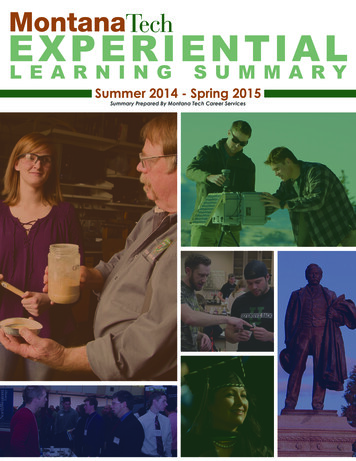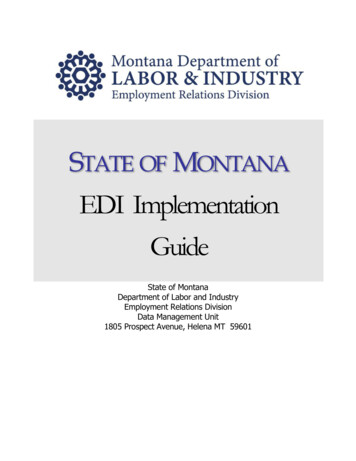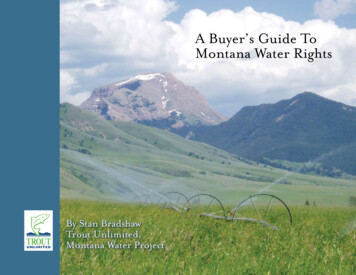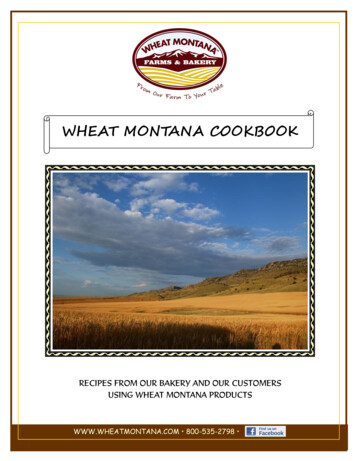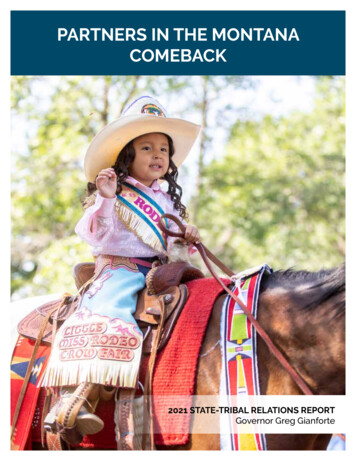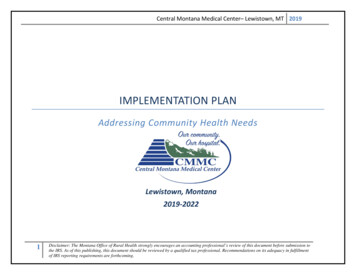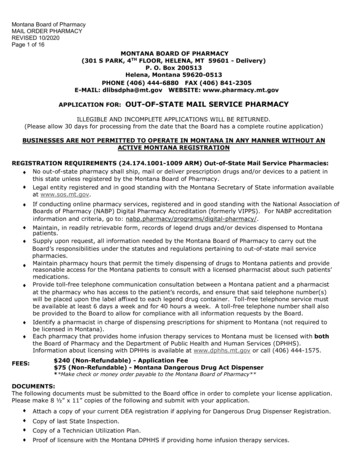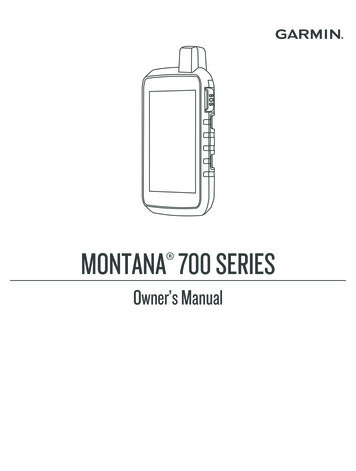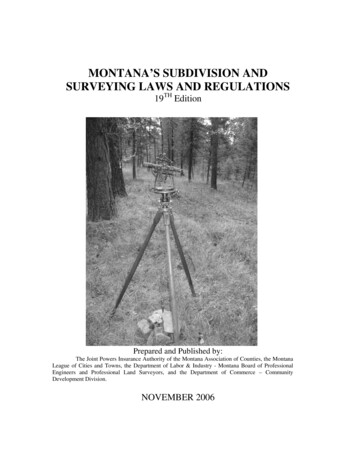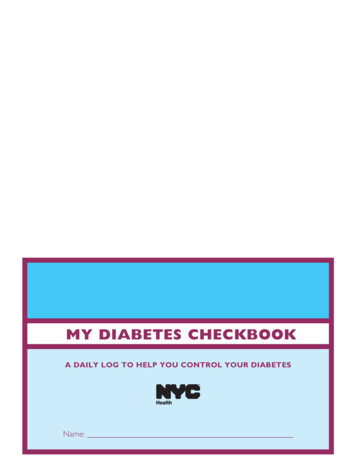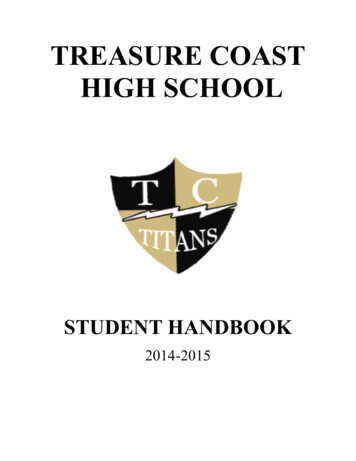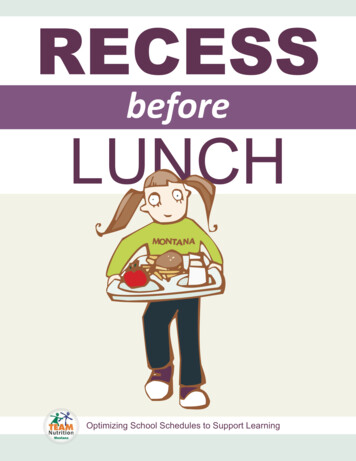
Transcription
RECESSbeforeLUNCHOptimizing School Schedules to Support Learning
RECESS BEFORE LUNCHOptimizing School Schedules to Support LearningThis guide, also available electronically on the Montana Team Nutrition Program tmeals/rbl.html, provides information, tips, and bestpractices for schools interested in using Recess Before Lunch to maximize learning and optimize meal time.For more information contact:Montana Team Nutrition ProgramKatie Bark, RDNkbark@mt.gov Phone: 406-994-5641Molly Stenberg, RDNstenberg@montana.edu Phone: 406-994-7217Montana State University325 Reid Hall, PO Box 173370Bozeman, MT 59717-3370www.montana.edu/teamnutritionMontana Office of Public InstructionSchool Nutrition ProgramsChris Emerson, MS, RDcemerson@mt.govPO Box 202501Helena, MT 59620-2501Phone: 406-444-2501, Fax: t-Operations/School-NutritionAcknowledgmentsIn accordance with federal law and U.S. Department of Agriculture policy, this institution is prohibited fromdiscriminating on the basis of race, color, national origin, sex, age, or disability. If you wish to file an Officeof Civil Rights complaint for discrimination, complete the USDA Program Discrimination Complaint Formfound online at www.ascr.usda.gov/complaint filing cust.html or at any USDA office, or call866-632-9992 to request the form. You may also write a letter containing all of the information requested inthe form. Send your completed complaint form or letter by mail to U.S. Department of Agriculture, Director,Office of Adjudication, 1400 Independence Avenue, S.W., Washington, D.C. 20250-9410, by fax to202-690-7442, or via email to program.intake@usda.gov.USDA is an equal opportunity provider and employer.This project has been funded at least in part with federal funds from the U.S. Department of Agriculture.The contents of this publication do not necessarily reflect the views or policies of the U.S. Department ofAgriculture; nor does the mention of trade names, commercial products, or organizations imply endorsementby the U.S. Government.Developed: 2018Developer: Dayle Hayes, MS, RDN, President of Nutrition for the Future, Inc.Advisory/Development Committee: Adrian Advincula, Principal, Bozeman Public Schools, Irving Elementary School, Bozeman, Montana Don Christman, Director of Special Programs, Lockwood Public Schools, Billings, Montana William (BJ) Biskupiak, Program Coordinator, Montana Department of Public Health & Human Services,Montana School Health Committee Carson Oetting, Health and Human Development Undergraduate Student, Montana State University Missouri and Iowa Team Nutrition Programsii Recess Before Lunch
Table of ContentsIntroduction.1Recess and lunch with the whole child and community in mind 2Benefits of active recess.3Benefits of balanced school meals.4Benefits of Recess Before Lunch.5Gaining support for Recess Before Lunch.9Strategies for successful scheduling. 11Recess Before Lunch checklist.15Recess Before Lunch toolkits and sample schedules.16Creating child-focused recess and lunch environments 19Strategies for successful recess.20Strategies for comfortable cafeterias.21Resources and research bibliography.23We know that Recess Before Lunch is best for our studentsand we see how it improves the learning environment inthe afternoon. It’s a schedule shift for our staff and wecontinually refine our approach with their input.”Montana School AdministratorOptimizing School Schedules to Support Learning iii
INTRODUCTIONIn 2003, the Montana Team Nutrition Program published Recess Before Lunch: AGuide for Success. After working closely with several schools to promote and assist in theimplementation of a Recess Before Lunch (RBL) schedule, the Montana guide was publishedto help other schools and districts learn how to implement a RBL policy at the elementary level.While the practice is now sometimes called “Play, Then Eat” or “Play Before Lunch,” the basicconcept of RBL has not changed since the publication of the original guide:Recess Before Lunch is simply a change in the traditional scheduling order of lunchtimeand recess. As the name implies, RBL allows students to go to recess first, and then eatlunch. While it sounds simple in theory, schools often find that this policy change requirescareful planning and efficient communication, as well as a strong commitment from schooladministrators, educators and food service staff to make the change successful.During the 14 years since its publication, the Montana RBL guide has been used throughoutthe state, across the country and around the globe. It has served as the basis for toolkitsdeveloped by Hawaii, Iowa, Missouri, Vancouver (Canada) and others. The U.S. Departmentof Defense’s Healthy Base Initiative also used the guide in a demonstration project to reducethe prevalence of obesity at military installations worldwide.Since 2005, the Montana Office of Public Instruction (OPI) has collected yearly data onthe use of a Recess Before Lunch schedule in Montana schools. The rate has remainedconsistent at 30 to 34 percent of elementary schools implementing RBL for some or allstudents in kindergarten through eighth grade. The nationwide 2014 School Health Policiesand Practices Study (SHPPS) survey by CDC reported that about 62 percent of elementaryschools offer RBL to some students, with 11 percent scheduling it for all students.Students are not rushing through lunch to get out to recess.They are hungrier when it’s time for lunch, so they eat better.”Montana Teacher1 Recess Before Lunch
YN eWellnessCOMMUNITYRECESS AND LUNCHWITH THE WHOLECHILD ANDCOMMUNITY IN MINDOver the past ten years, the role of school health, especially the importance of nutrition andphysical activity, has continued to evolve. The original coordinated school health model fromthe Centers for Disease Control and Prevention (CDC) was expanded to the Whole School,Whole Community, Whole Child (WSCC) model. According to the CDC, this model (illustratedabove) “focuses its attention on the child, emphasizes a school-wide approach, and acknowledgeslearning, health, and the school as being a part and reflection of the local community.”In the Whole Child Model, the scheduling of recess and lunch is important because of thenumerous connections among school success, nutrition and physical activity. Recess andlunch are also part of another important discussion in America’s schools: food waste. TheUS Department of Agriculture (USDA) has recognized that schools have a special rolein “reducing, recovering, and recycling food waste.” The U.S. Food Waste Challengespecifically recommends Recess Before Lunch and extending lunch periods as two importantstrategies for reducing food waste in schools.This guide focuses on the many benefits of an active recess and a comfortable lunch period,preferably in that order.Optimizing School Schedules to Support Learning 2
BENEFITS OFACTIVE RECESSPlanned periods of physical activity and play, also known as recess, have impressiveand well-documented benefits. According to the CDC, an effective recess period ismonitored by adults and allows children to engage with their peers in activities they choose.Regular recess is a win-win for students and educators since it provides health, cognitive,educational and social benefits including: Increased levels of physical activity Improved memory, attention, concentration and classroom on-task behavior Reduced disruptive behaviors in the classroom Improved social development (e.g., learning how to share and negotiate)Regular recess periods during the schoolday contribute to the 60 minutes of dailyphysical activity recommended for youthtoday. Based on the strength of researchconnecting activity to learning, healthexperts and educators are joining forcesto help all students be more active. Forexample, the Tennessee Departments ofEducation and Health have joined together toprovide resources for schools, families andcommunities on an Active Students, ActiveLearners website.3 Recess Before Lunch
BENEFITS OFBALANCEDSCHOOL MEALSNutrition and physical activity go hand-in-hand helping children to be fit, healthy andready to learn. School meals (lunch, breakfast, snacks and suppers) are planned to providethe key nutrients that many students are missing, including calcium, potassium, vitamin Dand dietary fiber. The balanced meals mandated by the U.S. Department of Agriculture(USDA) Meal Patterns provide the fuel students need to learn in school. Students who eatschool meals: Consume more milk, fruits, and vegetables during meal times Have better intake of certain nutrients, such as calcium and fiberIn numerous studies eating breakfast at school has been associated with better attendancerates, fewer missed school days, and better test scores. While the impact of school lunch hasnot been studied as thoroughly as breakfast, ongoing research shows that overall dietary intakehas an impact on school performance. Students who are poorly nourished and/or food insecureare at greater risk for problems at school. According to the 2017 Hunger in Our SchoolsReport from No Kid Hungry, educators recognize that some children are too hungry to learn.My son ate more of his lunches – much lesswas coming home uneaten.”Vancouver, Canada ParentIt’s obvious that their brains have beenfed and hydrated.”Hawaii TeacherOptimizing School Schedules to Support Learning 4
BENEFITS OFRECESSBEFORE LUNCHActive recesses and balanced school lunches are good for students and educators. Byswitching the usual order to recess before lunch, many schools have multiplied the benefitsand added another strategy to optimize learning for children. However, to maximize thebenefits, sufficient time needs to be scheduled for both recess and lunch. Playground andlunchroom environments also need careful planning.The benefits of RBL have been confirmed in a number of research studies since the original2003 Montana Guide for Success was published. These additional benefits — on top of thenormal benefits of recess and lunch — fall into four main categories: Improved consumption of school lunch: Studies have shown that children wasteless food, drink more milk and eat more fruits and vegetables when they have recessfirst. The decrease in food and milk waste has been significant in some studies and lessdramatic in others. Improved atmosphere in the lunchroom: Since students are not rushing to getoutside, the atmosphere in the lunchroom/cafeteria/dining area is more relaxed, andthus more conducive to eating slowly. Children are generally calmer, quieter and able tosocialize as well as eat their meals. Improved classroom behavior after lunch: Teachers report that students are moresettled when they return to their classrooms and better able to focus. Administrators andeducators report better learning readiness and small, but important, increases in teachingtime (even 5 to 10 minutes makes a difference). Improved behavior overall: Anecdotally, administrators report fewer disciplineproblems in dining areas and hallways. Some also report that there are fewer conflicts onthe playground and that fewer children get sick from playing hard right after eating quickly.A one-page handout summarizing these benefits is available for downloading,sharing and printing at 26%2018.pdf5 Recess Before Lunch
For many schools in Montana and around the country, RBL is now the normal scheduling. Forsome others, the barriers seem nearly insurmountable. What makes the difference?For Irving School Principal Adrian Advincula, Bozeman, Montana, where all 276 students K-5enjoy RBL, the key is to have an open mind.“We are continually educating our staff and fine tuning our schedule. If something is notworking, we look at the process and figure out ways to make it work better. We wanteveryone on board and need to educate our staff and parents on research based benefitsto student learning and the overall school environment. It is an ongoing process but it isnow one of our core values. We know it is best for our kids.”Don Christman is the Director of Special Programs for Lockwood, Montana, Schools whereall 1,146 students K-7 have RBL every day. His view is much the same:“We focus on the needs of our students. Recess before lunch is the way we do thingsbecause it is best for students, especially high need students. They are calmer in thecafeteria, they eat better at lunch, and they are more relaxed going back to the classroom.While administration provides the leadership, we invite staff to participate in findingsolutions to the details of scheduling, handwashing and where to put coats and boots.”Both of these administrators hit on several key points that have helpedschools across the U.S. successfully enjoy the benefits of RBL.As many experienced school staff know, RBL is more than justa simple flip-flop in the schedule. It works best when schoolsmake sure that both recess and meal environments work wellfor both students and staff.Optimizing School Schedules to Support Learning 6
RECESS BEFORE LUNCHA Wellness Policy Strategy80%32%of Montana Elementary Schoolsuse Recess Before Lunch (RBL) schedulingfor all or some of their students.of Montana Principalssurveyed2 report1Greater nutrientconsumptionwith less food and beverage wasteData from a Montana RBL pilot project3 shows anoverall decrease in average food and beverage wasteafter implementation of a RBL policy.Additional findings included: Fewer unopened milk cartons more studentsopening and drinking milk which nourishes thebody and brain. Lunchrooms were more relaxed, quiet andconducive to eating, as students were notrushing to get outside. Children returned to class more settled, calmerand ready to learn. Because they had eatenwell, they tended to stay focused throughoutthe afternoon. Improved student behavior onthe playground, in the lunchroom and in the classroom. Increased lunch consumption. Decreased food waste.Time to eat matters!Scheduling lunch periods to be at least20 – 30minutesdecreases food waste4 and allows studentsenough time to eat a balanced meal. Schoolscan also stagger grades into the lunchroom tominimize time spent waiting in the lunchline and maximize time to eat.Experts recommend that children have at least20 minutes of seated time (once they sitdown with their meal) to enjoy a completeschool lunch or a lunch from home.Learn more from Montana’s Recess Before Lunch Guide, published 2018 bl.htmlFor more information: Montana Team Nutrition, www.montana.edu/teamnutrition, (406) 994-5641; kbark@mt.gov or stenberg@montana.eduRecess Before Lunch: A Wellness Policy Solution references:1. Montana Department of Public Instruction (OPI) School Nutrition Programs, National School Lunch Program data for Montana Schools. (2005–2016)2. The Montana Office of Public Instruction School Nutrition Programs Principals Survey. Published 2008. Accessed October 26, s/RBLSurveySumRpt%20new%20opi%20logo.pdf3. A Recess Before Lunch Policy in Four Montana Schools: Pilot Project Report. Published 2003. Accessed October 26, s/RBL%20pilot%20project%20report.pdf4. Bergman, E.A., Buergel, N.S., Femrite, A, Englund, T.F. (2003). Relationships of Meal and Recess Schedules to PlateWastein Elementary7 RecessBeforeSchools.Lunch (R-71-03). University, MS: National Food Service Management Institute. AccessedOctober 26, 2017. waste-and-recess-schedule.pdf
Optimizing School Schedules to Support Learning 8
GAINING SUPPORTFOR RBLEducate staff: Educate yourself and your staff, including teachers, all aides, secretaries, nutrition staff,and custodians on the potential benefits of RBL. If possible, visit firsthand, or at leastcontact, another school that is using RBL. Share information and discuss concerns at astaff in-service. Share a handout on RBL benefits. Make a commitment to give a RBL schedule a fair chance; commit to staying with it forat least a year. Be ready to make adjustments as needed in the first few months. Involvestaff in identifying areas of concerns and brainstorming solutions. Involve school nutrition staff at every step of the process. They will need to makeadjustments and will be key to the success of any meal service. Expect some resistance to change and be ready for the small problems that arise. Alwayskeep the benefits front and center: More activity and better nutrition enhance learningenvironments and improve behavior.Recess before lunch benefits everyone.Once you get the process in place, itbecomes second nature to the students.”Montana School Nutrition Staff9 Recess Before Lunch
Educate parents: Share RBL benefits and links through all the channels that you currently use to educateparents, including school website, newsletters, bulletin boards, teacher conferencesand meetings. Include RBL information in your social media postings using #recessbeforelunch as ahashtag. Here are two sample messages that can be used on any channel:· Our school has #recessbeforelunch, students play then eat. This way they consumemore nutritious @SchoolLunch & more milk· Our #recessbeforelunch schedule means that students play first. They eat better @SchoolLunch & lunches from #home too Emphasize that RBL will be equally beneficial to students who bring a lunch from home.When students have a more relaxed atmosphere in which to eat lunch, they are likely tobring less uneaten food home. Include RBL information/benefits/tips with all school lunch menus provided to parents.Educate students: Any change in scheduling can be successful if students understand the reasons and process. Engage student leaders to promote the new schedule on campus and ask for studentfeedback when appropriate. Student council members and other leaders can also beinvolved in trouble-shooting minor glitches to help the process run more smoothly.Educate the community: Share the benefits/concept of RBL at a Parent Advisory Council Meeting, or in an articlein the local and school newspaper. Share a handout on RBL benefits.If you eat lunch before recess, you get a tummy ache.”Montana StudentklOptimizing School Schedules to Support Learning 10
STRATEGIES FORSUCCESSFULSCHEDULINGPlan your schedule carefully Meet with all of the staff involved, especially those directly affected by the schedulechange (teachers, aides, school nutrition and custodians) to work out any possible kinks. Plan procedures for all cafeteria/lunchroom needs, like how to bring cold lunches fromclassrooms or lockers, where to store them during recess, and process for handlingwinter clothing and boots. Realize that any schedule is a work in progress, which may need to be tweaked severaltimes. Some schools conduct a trial run or pilot for several weeks to identify issues, andthen modify it as needed. See examples of schedules from Montana schools.Allow adequate time for recess,lunch and transitions The Centers for Disease Control and Prevention (CDC) and other national organizationsrecommend giving elementary school students at least 20 minutes of recess daily.Successful recess requires planning, supervision and support. Read more aboutStrategies for Recess in Schools. Scheduling a minimum of at least 20 minutes for lunch from the time they sit downwith their tray (i.e. seat time) is recommended, but the actual amount of time neededis dependent on the age and number of students being served in the school. ManyMontana schools allow 25–30 minutes total for lunch, especially for younger studentswho generally require more time to get through the serving line and to eat. Try to maximize time to eat while minimizing the time spent waiting in the lunch line. Students may need time to adapt to longer lunch periods and to eat more slowly. Havingadult mentors eat with students and practice conversations can help. Read more aboutCreating Comfortable Cafeterias on Montana Team Nutrition’s website.11 Recess Before Lunch
Create positive transitions Schools know that transition times, especially those involving going outdoors, comingindoors and moving as a group into other spaces, have the potential to be disruptive. There are plenty of ways to get students focused for lunch and back into learning modein the classroom. The key lies in creating structured, orderly routines and providingengaging, calming tasks that work for various grade levels. For example, using a rotationof student leaders or singing a special song. Invite experienced teachers and other staff to share their ideas for effective transitionsand to mentor others in routines that work.Develop a detailed hand washingplan in the schedule Hand washing is an important food safety issue and disease prevention strategy. It is oneof the most frequently identified barriers to implementing RBL. The following procedure has been approved by the Montana Department of Public Healthand Human Services Registered Sanitarians:Include a hand washing plan in the lunch schedule. Hand washing is an important foodsafety issue that should not be overlooked. Most school schedules are written so that thechildren come in from recess, put coats away, wash hands, and then enter the lunchroomas a group. Washing hands with soap and water is the recommended method for cleaninghands. The use of a hand sanitizer is not effective in cleaning hands. Hand sanitizers aredesigned to work in addition to hand washing when applied to already clean hands. Formore information, contact the local county sanitarian at the health department.Optimizing School Schedules to Support Learning 12
Increase the presence of staff wheninitially implementing a RBL Increase the presence of adults on the playground and in the cafeteria as RBL isbeing implemented. This helps ease the transition into and out of the cafeteriaand provides extra supervision as the students learn a new routine. Administrators, other school staff and trained volunteers (like parent volunteers,aides and curriculum/education coaches) should spend as much time as possiblein the lunchroom and hallways, especially during the first couple of weeks of RBL. Students need to practice new routines and they need supervision duringtransition times. The presence of adults demonstrates support for RBL and theschool lunch program, while enhancing the atmosphere of the lunch period. Continually provide students with clear and simple directions and show them howto meet expectations.Children seem to be less antsy, tend to eat more, and waste less.”Hawaii TeacherThey have better appetites and are a lot quieter. They eat more of their lunch.”Missouri School Nutrition Staff13 Recess Before Lunch
Advice from RBL Schools Scheduling changes are do-able; they take some creative planning andflexibility. Expect the schedule to be a work in progress. After the scheduleis in place, no extra staff should be required as a result of the change. Look past the logistics of the scheduling change and focus on what is bestfor the students. Collect and share examples of positive changes seen onthe playground, in the dining areas, and in the classroom. Students may be hungrier and thirstier with this change. It is a goodopportunity to promote a school breakfast program or to temporarily offer asecond chance breakfast service or morning snack. Since school nutritionprograms are required to have water accessible in areas where meals areserved, this is an excellent time to check the availability and replenishwater as needed. Since younger students (K-2) may accept the change in scheduling betterthan the older kids, pilot RBL with younger grades first. RBL can be implemented in a variety of ways. Schools in Montana haveRBL schedules during all lunch periods or some lunch periods, withstudents in all grades or selected grades only. Some schools switch in themiddle of year, so grades/classes have RBL during the first semester andothers have it during the second semester.Optimizing School Schedules to Support Learning 14
RECESS BEFORELUNCH CHECKLISTUse this checklist to consider all the issues involved in the successful scheduling of RecessBefore Lunch. Adapted from Iowa Recess Before Lunch Guide produced by the Iowa Team Nutrition Program.Key issues for RBL successAre school administrators supportive?Are teachers and aides supportive?Is the school nutrition program supportive?Would current school nutrition staffing schedule work with RBL?Have nearby schools with RBL been contacted for best practices, sample schedules, etc.?How will students and parents have chance to provide input on RBL?How will all affected staff (teachers, school nutrition, aides, custodians) be able toprovide input on RBL?Is there a plan to assess success pre- and post-RBL with data collection of food/beverages consumed vs. wasted?How much seated time will students have to eat lunch (at least 20 min.)?Is there a plan for adequate staff coverage of recess, lunch and transitions?Is there a plan for storage of coats, boots and other outdoor gear?Is there a plan for effective handwashing procedures (page 12)?Is there a plan for the safe management of lunches brought from home?Is there a plan for the management of students with food allergies and other specialmedical needs?Next steps:15 Recess Before LunchYesNoMaybe
HELPFUL TOOLKITSAND SAMPLE RBLSCHEDULESThese three toolkits provide additional information and tips for implementing RecessBefore Lunch.Hawaii: Recess Before Lunch for Hawaii SchoolsIowa: Recess Before Lunch GuideThis guide reports the details of a Recess Before Lunch pilot in three Iowa schools, as well asa section on how to conduct a plate waste assessment.Missouri: Recess Before Lunch Toolkit for Missouri SchoolsRecess Before Lunch has eliminated the ‘rush to eat and get outside.’ Studentsenter the cafeteria more calmly, they eat more calmly and they have feweroffice referrals once they return to the classroom.”Missouri School AdministratorOptimizing School Schedules to Support Learning 16
Examples of Montana School SchedulesGrades K–6Grades K–5115 students280 studentsK123458:30 a.m. Class StartsRecessK– 45–68:25 a.m. Class StartsRecess9:45–10:009:45 – 0:30–10:45RecessRecess11:15 – 11:35Lunch11:35 – 12:0010:50 – 2:25Lunch11:15 – 2:50Recess1:15–1:30RecessRecess2:00 – 2:15RecessRecess2:45–3:002:00 – 2:152:30 – 2:453:30 p.m. Class Dismissedi17 RecessBeforeLunch RecessBeforeLunch
Examples of Montana School SchedulesGrades 3–5Grades 5–8150 students680 students34–5568:25 a.m. Class Starts788:40 a.m. Class Starts1st Period8:40 – 9:32Recess9:45 – 10:002nd PeriodRecess9:37 – 10:2410:00–10:15Recess10:15–10:303rd Period10:29 – 11:16Recess11:20 – 12:25RecessLunch11:42 – 12:03Lunch4th Period11:21 – 12:08Recess12:00–12:2512:08 – 12:31Lunch12:31 – 12:535th Period12:58 – 1:456th PeriodRecess1:50 – 2:372:00 – 2:155th and 7th grades have firstlunch during 1st and 3rd quarters.6th and 8th grades have firstlunch during 2nd and 4th quarters.7th Period2:44 – pportSupportLearningLearning 18iiOptimizing
CREATINGCHILD-FOCUSEDRECESS AND LUNCHENVIRONMENTSPositive recess and lunch experiences do not happen by accident. Like any otheraspect of CDC’s Whole School, Whole Community, Whole Child (WSCC) model, bothrequire planning and support to be successful. Fortunately, there are resources to helpschools in the process. Whether your school uses a Recess Before Lunch schedule or not,these resources can help your leadership team and school wellness council create plans anddevelop policies that are focused on children’s needs.This policy is helping my child to eat better and enjoy his lunch more.Montana ParentI can play soccer sooner; we get to play before we go to lunch.Montana Student19 Recess Before Lunch
Strategies for successful recessThe 2017 Strategies for Recess Success from CDC and Society of Health and PhysicalEducators (SHAPE) outlines five categories of strategies, including Recess Before Lunch. Italso provides a recess planning template and detailed instructions for how to implement eachof the strategies at Centers for Disease Control and Prevention (CDC): Recess.Make Leadership Decisions1. Identify and document recess policies.2. Put documented recess policies into practice and revise as needed.3. Develop a written recess plan.4. Designate spaces for outdoor and indoor recess.5. Establish weather guidelines to ensure student safety.6. Train school staff and volunteers for recess.Communicate and Enforce Behavioral and Safety Expectations7. Establish and communicate behavior management strategies.8. Teach conflict resolution skills.9. Ensure that recess spaces and facilities meet recommended safety standards.Create an Envi
Optimizing School Schedules to Support Learning. This guide, also available electronically on the Montana Team Nutrition Program website, . Billings, Montana William (BJ) Biskupiak, Program Coordinator, Montana Department of Public Health & Human Services, Montana School Health Committee . Recess and lunch with the whole child and .
